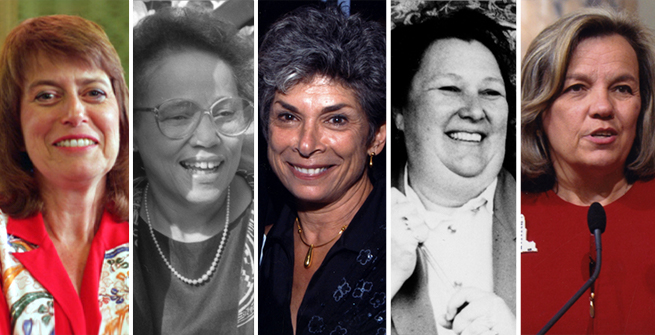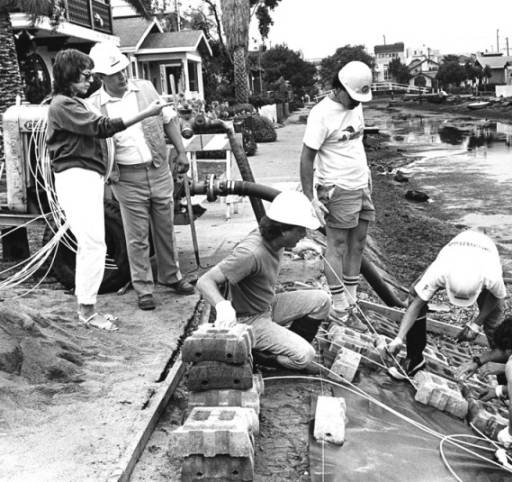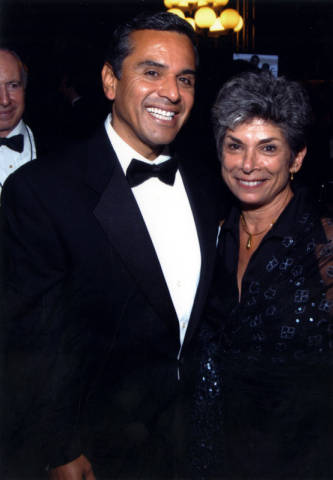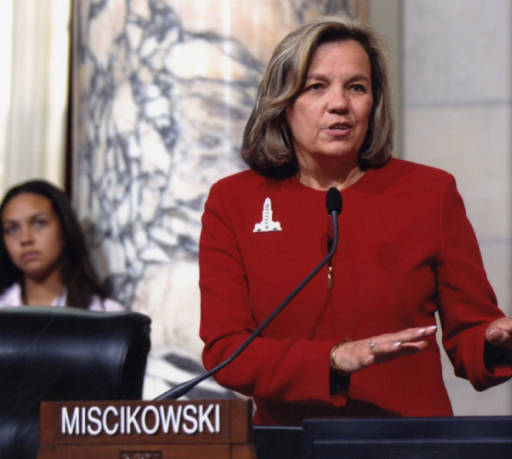During this third week of Women’s History Month, we are back with another post highlighting the women who have served on the Los Angeles City Council. This week’s councilmembers are: Ruth Galanter, Rita Walters, Laura N. Chick, Jackie Goldberg, and Cindy Miscikowski.
Ruth Galanter [b. 1941] 6th Council District, 1987-2003
Westchester, Playa del Rey, Venice, Mar Vista, Baldwin Hills/Crenshaw (pre-2002)
Sun Valley, North Hollywood, Van Nuys, North Hills, Panorama City (post-2002 redistricting)
Westchester, Playa del Rey, Venice, Mar Vista, Baldwin Hills/Crenshaw
Ruth Galanter rode in on a wave of anti-growth sentiment when she unseated 18-year incumbent Pat Russell to represent the 6th Council District on the Los Angeles City Council. A stranger to the city’s political machine, Galanter was already well known in environmentalist circles. She had served as a director of the California League of Conservation Voters and on the South Coast Regional Coastal Commission. As councilwoman, Galanter successfully introduced many slow-growth measures and played a key role in saving the endangered El Segundo Dunes habitat area and restoring the Ballona Wetlands. Galanter’s willingness to approve certain projects, especially those with developer-funded community amenities, drew the ire of some anti-development groups. Nonetheless, she won her reelection bid in 1991. The victim of a near-fatal home invasion just prior to her election, Galanter also focused on public safety measures, such as organizing Neighborhood Watch clubs throughout her district, overseeing the opening of a new LAPD substation at the Baldwin Hills Crenshaw Plaza, and arranging for increased security in area parks. She went on to be reelected in 1995 and 1999, serving as President Pro Tempore, oversaw improvements like the construction of libraries, restoration of the Venice canals and pier, and installation of recycling facilities. Galanter cited an ordinance requiring low-flush toilets in homes as her most lasting legacy. In 2002, Galanter was redistricted away from the Westside and into the San Fernando Valley. Although displeased with the decision, Galanter endeavored in getting to know the community and working on projects to clean up large amounts of illegally dumped refuse. After leaving the Council in 2003 due to term limits, Galanter worked as a lecturer and distinguished scholar at local universities and ran her own consulting business. She continues to volunteer for wetlands restoration projects.
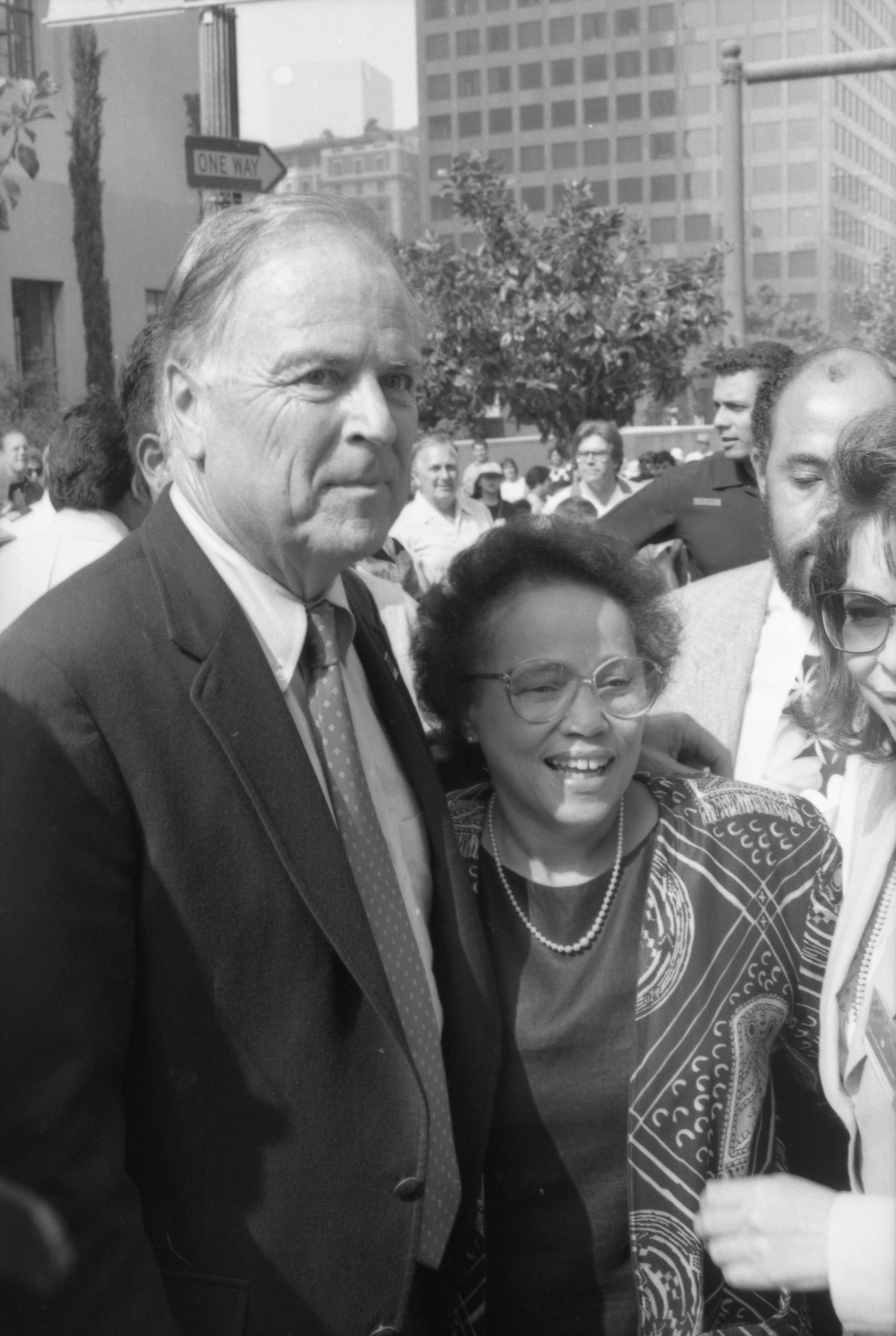
Rita Walters [b. 1930 – d. 2020] 9th Council District, 1991-2001
South Park, Civic Center, Financial District, Bunker Hill, Little Tokyo
A former teacher, Rita Walters was elected to the board of the Los Angeles Unified School District (LAUSD), where she served from 1979 to 1991. A strong advocate for racial equality in the schools, Walters was a part of the minority of school board members who supported mandatory busing. In 1991, Walters took her fight to City Hall, winning a special election for the 9th Council District seat and becoming the first African American woman on the Los Angeles City Council. Her district was hardest hit during the 1992 riots; she established an emergency hotline for residents and helped coordinate services with churches and community organizations. She shepherded through an ordinance to speed up the rebuilding process for “non-controversial establishments” by waiving the normal hearing process while imposing stricter operating guidelines for liquor stores. Walters was an early critic of police officers’ use of force, and she questioned LAPD’s commitment to recruiting a diverse force. However, she valued public safety efforts in her district, supporting a tax increase to add 1,000 officers to the police force, and advocating for increased foot patrols. Reelected in 1993 and 1997, Walters was notable for her principled stances. In 1997, she stunned the city when she voted against a planned downtown arena (which became the Staples Center) in her district, citing concern about the city’s financial obligation should the project fail. A lover of education and the arts, she chaired the Council’s Arts, Health and Humanities Committee, which oversaw the library department. Her Council tenure ended in 2001, and she was appointed to the Board of Library Commissioners, where she served from 2002 until her retirement in 2017.
Laura N. Chick [b. 1944] 3rd Council District, 1993-2001
Woodland Hills, Tarzana, Reseda, West Hills, Winnetka, Canoga Park
In 1993, Laura Chick unseated 16-year incumbent and her former boss, Joy Picus, to represent the 3rd Council District on the Los Angeles City Council. Chick quickly emerged as a vocal critic of wasteful practices and irked her colleagues by questioning their choice to give themselves raises during a recession. Chick was the first woman to chair the Council’s Public Safety Committee during an era with a strong crime reduction sentiment. Chick tempered her advocacy for law enforcement by challenging the LAPD’s lenient disciplinary system. After the Rampart scandal was exposed, Chick advocated for the adoption of a federal consent decree to hold the LAPD accountable for violating civil rights. Chick came out against the Valley secession movement but warned it was a strong message that citizens desired a more responsive and effective government. Publicly neutral on the new city charter approved in 1999, Chick headed the panel to oversee its implementation. After term limits ended her Council tenure in 2001, Chick became the first woman to hold a city-wide office as City Controller. Chick used her position to aggressively audit city departments, and notably revealed a backlog of thousands of untested DNA rape kits at the LAPD. Chick later served as state Inspector General overseeing nearly $50 billion in federal stimulus funds during the great recession. Chick has retired from public office but continues to lend a voice to important political issues. Most recently, she called on city councilmembers to stop accepting contributions from the police union as it serves "to protect bad apples and thwart a really thorough, transparent disciplinary system."
Jackie Goldberg [b. 1944] 13th Council District, 1993-2000
Hollywood, Silver Lake, Echo Park, Atwater Village, Glassell Park, Mt. Washington
Jacqueline (Jackie) Goldberg grew up in a working-class Inglewood neighborhood and was an activist by high school; her politics became more radical as a founder of U.C. Berkeley’s Free Speech Movement of the 1960s. Goldberg went on to teach at Compton High School and was involved in school desegregation efforts. She joined the LAUSD board, holding office from 1983 to 1991. After working as an aide to Councilwoman Gloria Molina, Goldberg was elected in 1993 in a narrow runoff victory to represent the 13th Council District on the Los Angeles City Council; she was unopposed for reelection in 1997. As the first openly gay or lesbian councilmember, Goldberg led the effort to provide benefits for unmarried domestic partners. Considered one of the Council’s most progressive members, Goldberg authored a landmark ordinance that guaranteed a living wage and benefits to all City of Los Angeles employees, developed a successful slum abatement program that held landlords accountable to the city and provided redress to tenants and created an after-school enrichment program for middle and high school students. Goldberg was also credited by the business community as instrumental in the revitalization of an earthquake damaged and crime-plagued Hollywood. Goldberg went on to serve in the State Assembly, where she authored many successful education-related bills and passed historic legislation giving LBGT couples comparable rights to married spouses. Most recently, Goldberg has returned to the LAUSD board, winning a 2019 special election in a landslide victory with the backing of the teachers’ union.
Cindy Miscikowski [b. 1948?] 11th Council District, 1997-2005
Brentwood, Pacific Palisades, Woodland Hills, Tarzana, Encino
Cindy Miscikowksi was a knowledgeable City Hall veteran when she was elected to the Los Angeles City Council to represent the 11th Council District in 1997. As deputy to Councilman Marvin Braude for over 20 years, she authored two significant voter-approved initiatives, one which imposed density limitations throughout the city and another which banned oil drilling on the city's coastline. Though criticized for being too close with developers, she worked to expand access to outdoor space and secured the preservation of thousands of acres of open space in the Santa Monica Mountains for public recreational use. Miscikowski served as chairwoman of the high-profile Public Safety Committee for five years, where she oversaw the implementation of LAPD reforms mandated by a federal consent decree related to the Rampart scandal. She opposed the San Fernando Valley secession movement, arguing that public safety services to the area would suffer. She was one of the few council members who supported the voter-approved new city charter of 1999, which among other provisions created the city-wide neighborhood councils. Reelected in 2001, Miscikowksi was selected Assistant President Pro Tempore and President Pro Tempore during her second term. Near the end of her tenure, she helped negotiate an $11-billion modernization plan for Los Angeles International Airport. Stymied by term limits, Miscikowski left the Council in 2003. She has since served on the Harbor Commission, worked as general and managing partner of a family real estate investment firm, and served on the board of directors of numerous nonprofit organizations, including the Los Angeles Police Foundation, the Music Center, and the Hammer Museum.
